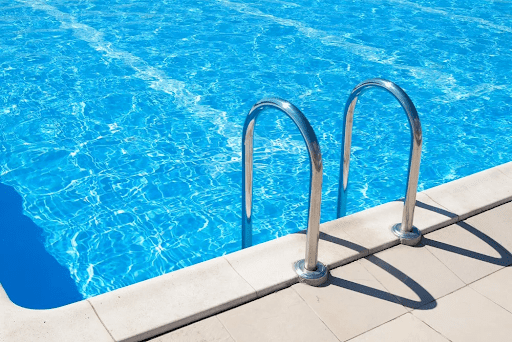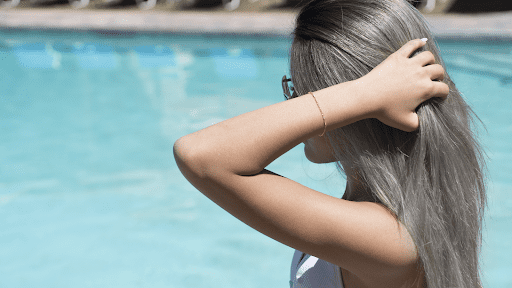When going swimming in the pool, in addition to protecting the skin, the hair, particularly color-treated hair, is a matter of concern. Without proper protection, hair is highly vulnerable to damage from the sun and swimming pool water.
How to protect color-treated hair while swimming? This article will give you essential information so that you can swim pools without fear of damaging your hair.
How Does Swimming In The Pool Damage Your Color-Treated Hair?
Chlorine is one of the chemicals your hair most often encounters in the summer. While keeping swimming pools safe and clean, pool chlorine harms swimmers’ hair.
The hair proteins that make up the hair strands are damaged by chlorine in the swimming pool, which affects its internal structure, making it more sensitive to damage and split ends.

Chlorine in water may harm your color-treated hair.
Chlorine also raises the hair’s cuticles, making it tough, porous, and hard to detangle. When chlorine is combined with UV radiation, the damage is substantially enhanced.
Chlorine strips the natural oils that cover the hair strands of their protective layer, making the hair more vulnerable to damage. Without adequate protection, swimming in chlorine pools may cause hair to become dry, lifeless, and brittle.
If you have dyed hair, chlorine may bond with the dye and swiftly remove it. Furthermore, as chlorine reacts with copper, a chemical reaction with a vivid blue-green hue is formed, which might cause your hair to look pale green.
Furthermore, your hair is not the only part of your head that might be damaged by chlorine. Long-term chlorine exposure can irritate the scalp, resulting in a dry, itchy scalp and dandruff.
How To Protect Color-Treated Hair While Swimming?
Before Swimming
Presoak
Many swimming pools encourage users to take a quick shower before entering the pool to remove dirt from their bodies and adapt their bodies to the water’s temperature.
Also, wetting your hair “ordinary” water before swimming will help it absorb less water in the pool, preventing chemicals from building up on your color-treated hair.
Wear a swimming cap
To protect your color-treated hair, wearing a latex swimming cap is an ideal option. However, a small amount of water can still infiltrate through the cracks.
Wet your hair before putting on your cap for increased protection.
Make a bun with your hair
How you wear your hair to the pool or beach might significantly impact maintaining it.
As much as possible, keep your head and hair out of the water. As you float about and swim in the pool, keep your strands out of the water with a lovely bun, braid, or topknot to reduce the area of hair exposed to water.

A girl with a hair bun to protect her hair color while swimming
Use professional hair treatments
Investing in items like a hydrating conditioner or treatment mask with high quality will help your hair’s color last longer.
Furthermore, they protect your hair from the damaging effects of the sun and water, which can cause them to fade faster.
Oil up
Among the most harmful side effects of chlorine and saltwater is its potential to dehydrate your hair, resulting in split ends and breakage. Also, chlorine and saltwater serve to deplete the gloss and brightness of the hair, making it look dull and lifeless.
Preparing your hair with rich oil is a straightforward approach. The oil will help produce a slick barrier between your strands and the potentially harmful water.
After Swimming
Wash your hair
If you do not rinse your hair right away, the chlorine will stick to the surface and be exceedingly tough to remove. Washing your hair will assist you in washing away the enormous amount of chlorine and reducing long-term damage to your hair.
After that, rinsing the hair with a conditioner can be beneficial. Conditioners can help prevent hair from becoming dry while still adding moisture and luster.

Washing hair right after swimming is essential after swimming
Use clarifying shampoo
After a swim, use a clarifying shampoo to get rid of all the chemicals that have accumulated in your hair. It will cleanse your scalp and hair of any dirt and pollutants.
Also, it will preserve the color of your hair.
On the other hand, Clarifying shampoo should only be used once or twice a month because it is very harsh on your hair and can rob it of moisture.
Deep conditioning
Swimming can cause your hair to become dried, necessitating the use of more than just a decent conditioner to revive it.
Deep conditioning not only moisturizes and nourishes your hair for a long time but also creates a protective barrier around your strands to keep out the things that make it dull, lackluster, and dry.
Dry your hair
Wet hair is fragile, especially after contact with chlorine, so do not violently rub it with a towel. Instead, wipe and massage your hair gently, or wrap it in a soft towel.
If feasible, allow your hair to air dry or use a low-heat blow dryer.
What Are Some Tips For Keeping Your Color-Treated Hair Safe When Swimming?
Do not swim for more than one hour
First, you should not swim for more than one hour at a time. It may seem harmless, but prolonged exposure to chlorine and the sun may cause your color-treated hair to fade rapidly.
Take some time away from the pool
If you can’t stand swimming for more than an hour at a time, set a timer for at least five minutes out of the pool every hour for the best practice.
If you do not have time to take regular breaks, properly blow-drying your hair will help prevent it from damage.
Apply coconut oil or olive oil to your hair
As mentioned above, applying oil is an excellent way to protect your color-treated hair while swimming. Coconut and olive oil are among the preferable ones.
A layer of nutritious coconut oil or olive oil may cover your hair to prevent chlorine from coming into touch with it, comparable to how you wash your hair with fresh water.
The oils operate as a water-resistant barrier, shielding it from chlorine and copper, which may be present in water and causes your hair to turn green. Apply the oil liberally from roots to your ends before entering the water.

Using olive oil after swimming is advisable to protect your hair.
Use chlorine-removing shampoos
Chlorine shampoos aid in the removal of chemicals that build up in hair after floating in pool water. It is enough for you to use it twice a week to reduce the adverse effects of pool chlorine.
It inhibits the yellowing of silver, blond hair and the appearance of a green tint. Chlorine shampoos also prevent hair from drying out by retaining moisture, leaving your tresses silky and lustrous.
Chlorine shampoos hold in moisture and leave your hair soft and silky, preventing it from drying out. Also, your hair is less knotted and easier to comb after removing chemical buildup.
Frequently Asked Questions
Is It Possible To Swim With Color-Treated Hair?
Yes, but you should take extra care, like applying an anti-chlorine conditioner and a swim cap to keep your hair dry and protected from chlorine before swimming.

You can swim with color-treated hair.
How Often Can I Swim With Color-Treated Hair?
You should avoid swimming at least 3-4 days after coloring your hair. The substances in the pool water will be less likely to impact the color of the colored hair as the pigments in the dye have set into the hair.
Besides, swimming pool water will gradually alter the color of your dyed hair, regardless of how long it has been dyed. As a result, you should maintain appropriate hair care to keep your hair’s color and strength.
Is It Possible To Shampoo My Hair After A Long Swim In A Pool?
Yes, but you should not use a regular shampoo when dying your hair because the detergent ingredient can fade the color.
Check your shampoo bottle’s components list and prescription information to ensure no effects are stated for color-treated hair.
Conclusion
Swimming pools contain chlorine to help clean the water; yet, it is harmful to hair. To assist you in protecting your hair, here are some suggestions for “How to protect color-treated hair while swimming?”
Hopefully, with this information, you will be able to enjoy your swimming sport without having to worry about your hair becoming dry and damaged afterward.
Leave a Reply